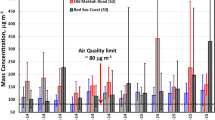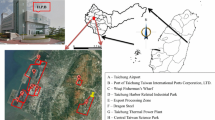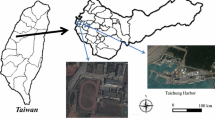Abstract
Atmospheric particulate matter may exert serious health hazards because of its chemical characteristics. The main objective of this study is to assess the concentrations of total suspended particles (TSP), particulate matter (PM) with an aerodynamic diameter ≤10 μm (PM10), and air-transmitted particulate trace metals in Tehran University (a central location in Tehran, capital of Iran) ambient air, for the period of 5 months viz. February–June 2007. Furthermore, the present work examines the daily levels of fine particles in comparison with the proposed limiting values from the U.S. Environmental Protection Agency (65 μg m−3 for PM10). The sampling for TSP and PM10 was performed using a high-volume sampler. The TSP and PM10 levels were determined by gravimetry and the metals by flame atomic absorption spectrometry. Arithmetic means of 151 ± 44 µg m−3 and 90 ± 38 µg m−3 were determined for TSP and PM10, respectively. Comparing with EPA primary and secondary air quality standards, only PM10 concentrations in 3 days were higher than the standard values. Heavy metal content of both TSP and PM10, such as chromium (Cr), cadmium (Cd), and lead (Pb), were also analyzed separately during the same period using atomic absorption spectrometry. The average concentrations of heavy metal in TSP were Pb: 183.63 ± 147.81 ng m−3; Cr: 13.72 ± 2.40 ng m−3; and Cd: 6.80 ± 1.97 ng m−3 and for PM10 were: 150.36 ± 157.01 ng m−3; Cr: 9.12 ± 2.14 ng m−3 and Cd: 6.87 ± 2.22 ng m−3.
Similar content being viewed by others
Explore related subjects
Find the latest articles, discoveries, and news in related topics.Avoid common mistakes on your manuscript.
Introduction
The sources, characteristics, and potential health effects of total suspended particles (TSP) and particles with aerodynamic diameter less than 10 μm (PM10) are very different. The aerosols emitted by the fixed and mobile sources have a variety of health effects that are known for a long period of time (Sharma and Maloo 2005). One of the most important components of the air pollution mixture that contributes in a various adverse health outcomes as well as general environmental effects is urban particulate matter (PM) (Van Der Zee et al. 1998). Regarding the size of urban particulate matter, it tends to be divided into three principal groups: coarse, fine, and ultrafine particles. Particulate air pollution has a both anthropogenic (manmade) and natural sources. Fine particles can be emitted directly, for example, as a result of combustion processes, or can form from chemical reactions of gases such as sulfur dioxide, nitrogen dioxide, and some organic gases. Coarse particles can be generally divided into rural, natural crustal material such as dust and urban particles such as road dust kicked up by traffic (called resuspended dust), construction and demolition, industries, and biological sources. It contains hydrocarbons, biological matter, organic and inorganic compounds, acid aerosols, and metals attached to a carbonaceous core (de Kok et al. 2006).
The relations between ambient particulate matter and heart disease were recognized in the nineteenth century when evidence showed that the number of hospital admissions increased on days that the ambient air concentrations of particulate matter was higher than the other days (Peters 2005). Many atmospheric processes including cloud formation, visibility variation, and solar radiation transfer can be influenced by atmospheric aerosols. The gaseous and particulate components of atmospheric aerosol have a noticeably role in the deterioration of air quality (Wu et al. 2002).
It is demonstrated that heavy metal content of TSP and PM10 can be toxic to living things at certain levels. Although they occur naturally but they can come from many different sources such as some mining industries, fossil fuels burners, garbage or tobacco burners, and even forest fires. Thus, as a result of industrialization, current environmental levels of metals can be elevated relative to naturally occurring levels. Several heavy metals, such as Pb, Co, Cd, Cu, and Cr, are considered hazardous contaminants that can accumulate in the human body, with a relatively long half-life. For example, it has been stated that Cd has a half-life of 10 years in the human body. Furthermore, metals are associated with a variety of health effects. For example, in experimental animals, cadmium can produce acute toxic effects on various organs such as the kidney, liver, pancreas, and lung (by inhalation); chromium (VI) compounds can cause chrome ulcers, corrosive reactions on the nasal septum, acute irritative dermatitis, and allergic eczematous dermatitis among subjects who have been exposed; and the toxicity of lead may largely be explained by its interference with different enzyme systems; lead inactivates these enzymes by binding to SH-groups of its proteins or by displacing other essential metal ions (WHO 2000).
The analyses conducted in many industrial countries have consistently shown that changes in daily death rates are linked with short-term changes in air pollution levels. Causing serious environmental risks, its effect has been examined extensively (Onder and Dursun 2006). Some studies show that total suspended particles (TSP) and metal concentrations follow a similar pattern but Beceiro-Gonzalez et al. (1997) found that, for the same area, TSP and PM10 metal distribution patterns were different (O’Donnell et al. 1976). There are many investigations on Pb, Cd, Hg, and other heavy metal levels in air and their toxic effects (Onder and Dursun 2006). This may result in a wide variability in the intake of some metals through food (e.g., seafood), drinking water, or air. High levels of airborne heavy metals such as Pb, Cd, and certain persistent organic pollutants may also cause neurodevelopmental and behavioral defects in children. Thus, in this study, we investigated the levels of TSP, PM10, and three most important heavy metals (Pb, Cd, and Cr) in the air. Also, we compared the differences between heavy metal content of TSP and PM10.
Materials and methods
Air-transmitted particulate matter (including TSP and PM10) was collected during the period of February 2007–June 2007 at one site located on the central part of the Tehran (35°45′20.90″N, 51°23′40.40″E, and 1,200 m above sea level). A large number of bookshops, workshops, and some educational institutions (e.g., Tehran University), schools, and colleges are located near this site (the map of sampling sites is shown in Fig. 1). The emissions from public and commercial transportation are the main source of air pollution at this site. The selection of the points and the sampling procedure to estimate the interest parameters took into account the Environmental Protection Agency recommendations (EPA 1997).
Forty-one ambient air samples of TSP and PM10 particles were collected on the glass fiber filters (203 × 254 mm) by using high-volume air samplers (GMV Inc., average flow rate 1.40 ± 0.05 m3 min−1 for TSP and 1.39 ± 0.04 05 m3 min−1 for PM10) for the analysis. The high volume is considered a reliable instrument for measuring the weight of TSP and PM10 in ambient air (USEPA—Method IO-2.1 1999). Two high-volume apparatus (one of them coupled with size-selective (cyclone) inlet for PM10) were used for sampling. The main difference between these two devices refers to the size of the particles that can reach the filter surface. The TSP sampler allows trapping the whole particulate, while in the PM10 system, only particles with a size ≤10 µm can be collected. With using glass fiber filters, the particles with 0.1–100 μm diameter or less are ordinarily collected. With a size-select inlet, particles with 10 μm diameter or less are collected on the quartz filter. Ambient samples were collected at a height of about 10 m (USEPA 1998) above the ground level. Pre-field filters are conditioned in a room of constant relative humidity and temperature and are gravimetrically tared (USEPA—Method IO-3.1 1999). The duration of each sampling period was 24 h starting at midnight (USEPA—Method IO-3.2 1999).
After air samples were collected, the loaded filters were returned to the laboratory and conditioned as before and then particle mass was gravimetrically determined by weighing filters after drying for 48 h in a desiccator. To measure the heavy metal content of TSP and PM10, the weighted filters were divided into two equal pieces using a cutter, and then the collected samples on glass fiber filters were extracted by acid extraction procedure (USEPA—Method IO-3.1 1999). The selection and preparation of filters, extraction, and analysis of heavy metals were carried out based on the USEPA method IO-3.1 and IO-3.2 (USEPA—Method IO-3.1 1999; USEPA-Method IO-3.2 1999). According to these procedures, the inorganics collected on glass fiber filters were extracted from one of the pieces of the filter strip with 50 ml of hydrochloric and nitric acid mixture (3:1) using a hot acid extraction procedure (USEPA—Method IO-3.1 1999).
After cooling, the three digestates were mixed and filtered with 0.45-mm Acrodisc syringe filters to remove any insoluble material. The heavy metal concentrations in each sample were determined by atomic absorption spectrometry according to standard analytical procedures (atomic absorption spectrophotometry is capable of quantitatively determining most metals at levels that are required by federal, state, and local regulatory agencies; USEPA—Method IO-3.2 1999).
Before analyzing the samples, the instrument was calibrated for Pb, Cd, and Cr. As per the USEPA method, stock solutions (of 1,000 ppm) were prepared and diluted to the range of working standards for individual metal just before their utilization. Using these working standards, the calibration graphs were prepared in the linear range of the optical density (0.04–0.8). The instrument was calibrated at three different levels (0.1, 10, and 100 ppm) for each metal. Exactly the same extraction and analysis procedure was employed for TSP and PM10 filter papers in order to examine the background heavy metal content of blank filter paper. As suggested in the method and to verify reproducibility and low background metal concentrations of reagent and filters, 5% of the total number of samples were taken as blank and analyzed for presence of specific metals. The filter blanks were found to have all metals higher than the minimum detectable limits (for Pb, Cd, and Cr were 2.2, 0.2, and 0.7 ng m−3, respectively; USEPA—Method IO-3.2 1999). The concentration of metals in sampled filter papers was found to be much higher than in blank filters.
The one-way analysis of variance (ANOVA) procedure was used to search for significant variabilities among the results. All statistical evaluations were performed with SPSS (SPSS Inc., ver. 11.0.5).
Results and discussion
The total concentrations of TSP, PM10, and their heavy metal content (mean ± SD) determined in this study are presented in Table 1. As shown in this table, both TSP and PM10 average concentrations are lower than EPA daily standards (EPA 1997) that are used in Iran. Furthermore, the higher concentrations obtained from April to June are lower than those were founded by El Desouky (1988). The average monthly temperatures, rainfalls, and mean TSP and PM10 concentration for the period of sampling are displayed in Figs. 2 and 3. As shown in the figures, good linear correlation (R 2 = 0.79) was observed between the mean TSP concentrations and the mean monthly temperatures. The increase in photochemical activity during days due to increased solar intensity can cause it (Chaloulakou et al. 2003). But monthly precipitations and TSP concentrations show a quite poor correlation (R 2 = 0.0092); this correlation has been shown by Simone Lorena Quiterio et al. (2004).
In order to compare the measured concentrations of interest parameters between various days of the week, the data from the study were divided into the following three groups: holidays, 1 day after holidays, and the other days. Variabilities between all three groups (including TSP and PM10) were not significant at the 0.05 level, but variability between groups was significant (P = 0.032) for Cd content of PM10. Although no significant differences were seen for other parameters, the mean concentrations of TSP and PM10 in 1 day after holidays were found higher compared with the other days (Table 2). The total concentrations of heavy metals found in this study are well in line with those previously reported for the Asian urban area (Fang et al. 2005). Mean lead concentrations were well below the both WHO standards (WHO 2000) and EPA ambient air quality standards (EPA 1997). As previously mentioned, the one-way ANOVA procedure was used to search for significant variabilities among these groups. Using this procedure, it was observed that variabilities between groups (holidays, 1 day after holidays, and workdays) were not significant at the 0.05 level (with the exception of Cd). The results of grouped data for TSP, PM10, and total metal concentrations are presented in Table 2. Variation of TSP and PM10 mean concentration recorded during the sampling period are presented in Fig. 4. According to this figure, average PM10 concentrations in 3 days were higher than NAAQS.Footnote 1 Results of the present study also showed that the Pb, Cd, and Cr content (an arithmetic mean) of TSP were 169.33 ng m−3 (0.1253% of TSP), 6.80 ng m−3 (0.0050% of TSP), and 13.72 ng m−3 (0.0098 % of TSP), respectively. Similarly, the Pb, Cd, and Cr content (an arithmetic mean) of PM10 were 132.53 ng m−3 (0.1824% of PM10), 6.87 ng m−3 (0.0093% of PM10), and 9.12 ng m−3 (0.0124% of PM10), respectively (Table 1). Variations in heavy metal content of TSP and PM10 during the sampling period are shown in Figs. 5, 6, and 7. As implied from Fig. 6, 77% of TSP and 79% of PM10 samples have Cd content higher than WHO annual average guideline (0.005 μg m−3) while concentrations of Cr in all samples were higher than the value of 2.5 ng m−3 (that corresponds to an excess of lifetime risk of 1:10,000) (WHO 2000).
Notes
National Ambient Air Quality Standards.
References
Beceiro-Gonzalez E, Andrade-Garda JM, Serrano-Velasco E, Lopes-Mahía P (1997) Metals in airborne particulate matter in La Coruna (NW Spain). Sci Total Environ 196:131–139
Chaloulakou A, Kassomenos P, Spyrellis N, Demokritou P, Koutrakis P (2003) Measurements of PM10 and PM2.5 particle concentrations in Athens, Greece. Atmos Environ 37(5):649–660
de Kok TM, Driece HA, Hogervorst JG, Briede JJ (2006) Toxicological assessment of ambient and traffic-related particulate matter: a review of recent studies. Mutat Res 613(2–3):103–122
El Desouky M (1988) Suspended particulate matter in the urban area in Kuwait. Environment Protection Department, Ministry of Public Health, Kuwait
EPA (1997) EPA’s Office of Air Quality Planning and Standards (National Ambient Air Quality Standards). Environmental Protection Agency, Washington DC
Fang GC, Wu YS, Huang SH, Rau JY (2005) Review of atmospheric metallic elements in Asia during 2000–2004. Atmos Environ 39(17):3003–3013
O’Donnell JW, Severs RK, Pier SM (1976) Metals in ambient air polluted and unpolluted areas. Sci Total Environ 5(3):231–242
Onder S, Dursun S (2006) Air borne heavy metal pollution of Cedrus libani (A Rich.) in the city centre of Konya (Turkey). Atmos Environ 40(6):1122–1133
Peters A (2005) Particulate matter and heart disease: evidence from epidemiological studies. Toxicol Appl Pharmacol 207(2):477–482
Sharma M, Maloo S (2005) Assessment of ambient air PM10 and PM2.5 and characterization of PM10 in the city of Kanpur, India. Atmos Environ 39(33):6015–6026
Simone LQ, Celia RS da Silvaa, Graciela A, Viviane E (2004) Metals in airborne particulate matter in the industrial district of Santa Cruz, Rio de Janeiro, in an annual period. Atmos Environ 38:321–331
USEPA (1998) SLAMS/NAMS/PAMS NETWORK REVIEW GUIDANCE; EPA-454/R-98-003
USEPA—Method IO-2.1 (1999) Compendium of Methods for the Determination of Inorganic Compounds in Ambient Air; Compendium Method IO-2.1; EPA/625/R-96/010a. Sampling of Ambient Air for Total Suspended Particulate Matter (SPM) and PM10 Using High Volume (HV) Sampler
USEPA—Method IO-3.1 (1999) Compendium of Methods for the Determination of Inorganic Compounds in Ambient Air; EPA/625/R-96/010a. Selection, Preparation and Extraction of Filter Material
USEPA—Method IO-3.2 (1999) Compendium of Methods for the Determination of Inorganic Compounds in Ambient Air; EPA/625/R-96/010a. Determination of Metals in Ambient Particulate Matter Using Atomic Absorption (AA) Spectroscopy
Van Der Zee SC, Hoek G, Harssema H, Brunekreef B (1998) Characterization of particulate air pollution in urban and non-urban areas in the Netherlands. Atmos Environ 32(21):3717–3729
WHO (2000) Air quality guidelines for Europe, 2nd edn. WHO, Copenhagen
Wu YS, Fang GC, Fu PP, Yang CJ (2002) The measurements of ambient particulates (TSP, PM2.5, PM2.5–10): chemical component concentration variation, and mutagenicity study during 1998–2001 in central Taiwan. J Environ Sci Health C Environ Carcinog Ecotoxicol Rev 20(1):45–59
Acknowledgement
The authors would like to thank the Deputy of Research and School of Public Health, Tehran University of Medical Science for financial grant for this research (project number 5356).
Open Access
This article is distributed under the terms of the Creative Commons Attribution Noncommercial License which permits any noncommercial use, distribution, and reproduction in any medium, provided the original author(s) and source are credited.
Author information
Authors and Affiliations
Corresponding author
Rights and permissions
Open Access This is an open access article distributed under the terms of the Creative Commons Attribution Noncommercial License (https://creativecommons.org/licenses/by-nc/2.0), which permits any noncommercial use, distribution, and reproduction in any medium, provided the original author(s) and source are credited.
About this article
Cite this article
Leili, M., Naddafi, K., Nabizadeh, R. et al. The study of TSP and PM10 concentration and their heavy metal content in central area of Tehran, Iran. Air Qual Atmos Health 1, 159–166 (2008). https://doi.org/10.1007/s11869-008-0021-z
Received:
Accepted:
Published:
Issue Date:
DOI: https://doi.org/10.1007/s11869-008-0021-z











